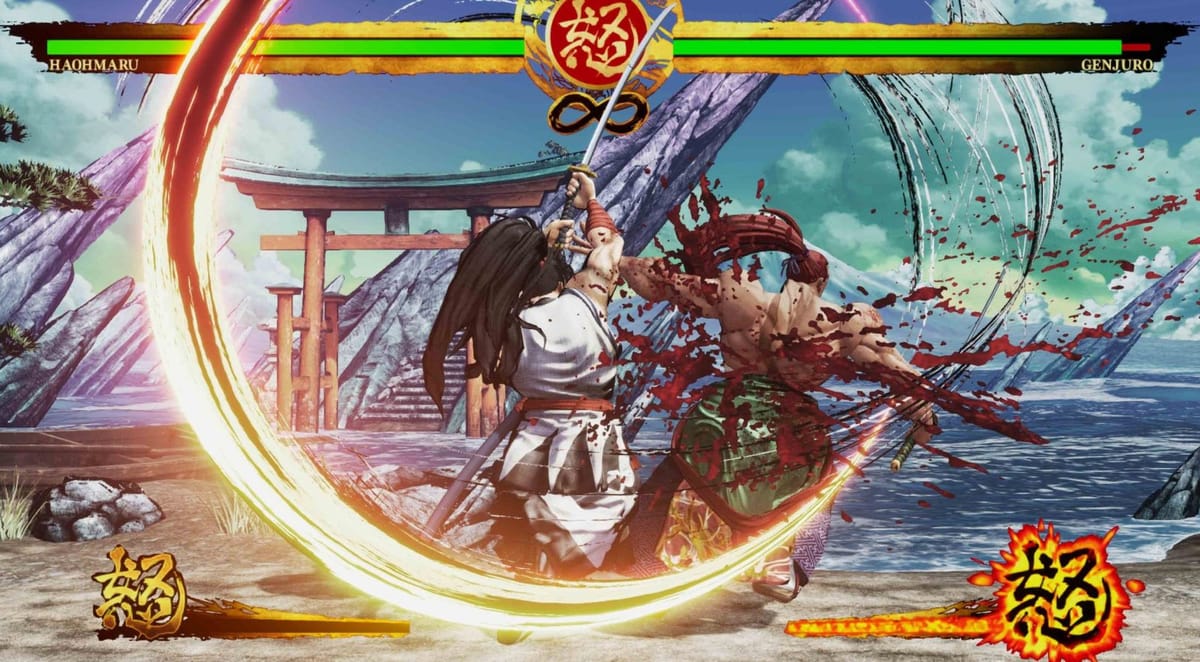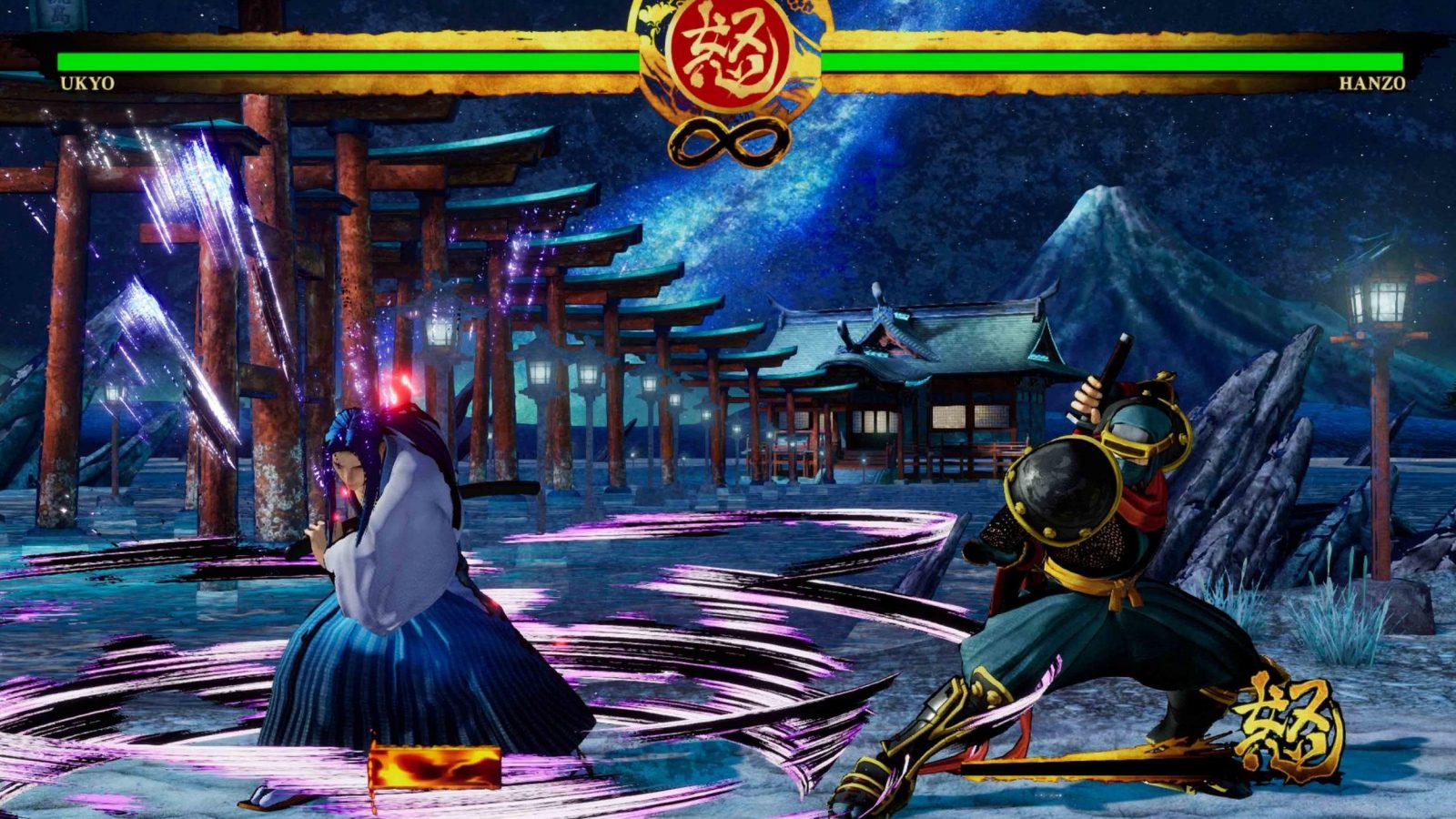
How I love a good fighting game. For as long as I can remember, I’ve been playing Samurai Shodown. I even fired up my SNES and Switch and to get a few quick rounds in of older iterations to see how far this version had come. Over the years, it’s been overshadowed by the likes of more popular fighting games such as Mortal Kombat, Street Fighter, Killer Instinct, and SoulCalibur, but Samurai Shodown remains in a league of its own by opting for a different style of combat in an age where combos and cutting-edge graphics reign. With this version including Season Pass 1 and Season Pass 2, it’s full of dynamic characters.
Now, with this being a PC port, I do have a few gripes that immediately caught my attention. Playing on PC, I noticed that the highest resolution that the game supported was 1080p, which left me with two massive gray bars on both sides on my display, because I have an ultrawide display. Even swapping to fill types just stretched the image as to where it no longer looked like a 1080p image. It’s 2020, there’s no reason higher resolutions aren’t an option in PC games. Also, regardless if v-sync is on or off, horrible tearing is present throughout the gameplay; and with no option to play at a higher FPS, I was down in the dumps before the game began. But all was not lost, because gameplay is what really matters.
Understanding that Samurai Shodown is a different type of fighting game, one must take full advantage of the modes available, especially the practice modes. There’s plenty of options for training and practicing so that you can hone your slicing skills. Aside from the plethora of practice modes, there’s an Online mode, where you can challenge other fighters in ranked matches, casual bouts, and check leaderboards. The Story(where the game shines) allows you to choose a character and play the game from their perspective and learn their story. The cutscenes are beautiful and the stories told are memorable. There’s a Dojo mode, which allows the computer to learn your fighting style and over a series of matches and pits you against yourself, and lastly, there’s the typical Battle mode, for offline, couch co-op battles. Out of those, the Story mode has been my favorite, as the developers put a lot of care into telling the stories of each fighter. In all, there are 24 different characters (including DLC) to choose from in the character select screen, with most of them being returning characters with new costumes and animations. Most characters have their own fighting styles, win animations, and personal style, giving the game a deeper feeling.
Where this game sets itself apart from the rest is with its fighting mechanics. I was blown away with how they chose to approach the combat. I found this rendition of Samurai Shodown to be one of skills, tactics, and mind games. Where Street Fighter, Killer Instinct, and other fighting games have opted to build their fighting systems around long, strung together combo systems that can be difficult for players to grasp, Samurai Shodown is about knowing your character’s and opponent’s movesets, and attacking at an opportune time. Though the previous versions of the game had faster gameplay, I can see why they chose to slow it down and allow the new fighting mechanics to shine. I began playing in Story mode to come to grips with the fighting mechanics. There are 24 characters available, thanks to the Season one and Season 2 DLC. I chose Haohmaru, a somewhat balanced Samurai that I have used on and off over the years. As the game chooses your opponent, you travel through a Street Fighter 2-like map to show where your opponent reigns from. The music leading up to battles is very reminiscent of the original games, setting the mood of intense battle. The art style, looking like it’s a water brushed painting, gives characters a classic look without losing much of what makes those characters memorable.
But the game is deeper than what’s on the surface. Once the battle began, I took notice of the Rage meter, which builds over time as you attack or are attacked. Using it allows you to move faster, and when full, permits you to pull off a devastating move, capable of slashing away 80% of your opponent’s health. That’s why it’s pertinent to know when and how to move. During the first few seconds of my first match, it was a stand-off. I noticed that my opponent was like a statue, and me, waiting for them to attack with a frenzy of slashes, was perplexed. At the time, I had yet to understand how this game had changed when compared to its predecessors. Fed up, I leaped into action, swinging my sword haphazardly with little results.
There is a weighty feeling when attacking, especially when using a strong attack. That’s to be expected, but when using a light or medium attack, I would expect characters to recover a bit faster and not leave themselves so open. You see, fighting in Samurai Shodown is like a chess match. You must understand your opponent and their capabilities, not simply attack and expect a win, because that will easily be your demise. At your disposal, you have a light, medium, and strong attack, that utilizes your weapon, and a regular kick. Like previous versions, your weapon can be knocked from your hands if hit with a strong enough attack, so blocking and spot dodging is essential. Because movements feel weighted and recovery is slower, you must spot dodge, which allows you to sidestep and counter if you wish. You can also deflect, which sends your opponent back in an off-balance stumble and leaving them open for an onslaught of attacks by you.
Whether you’re playing online or offline, I found that the combat timing, whether you are on the offensive, defensive, recovering, or simply landing from a jump, is a fraction off. For those who are uninitiated in knowing what timing is in fighting games; there’s a moment, usually a fraction of a second, when a character will be invulnerable, unable to defend or attack. It also goes the other way; there’s usually a moment when a character is vulnerable, either after a missed attack, ill-timed jump, etc., when they are at the mercy of their opponent. Here, the timing appears to be a fraction off, leaving players completely vulnerable or invulnerable to anything and everything, which takes the wind out of your sails.
Because fighting is about choosing the right time to attack or defend, maybe it’s supposed to feel that way, but it was difficult for me to discern because each character’s timing felt different. All fighting games have this, especially good ones. This timing allows you or your opponent to perform certain actions, but in Samurai Shodown, it feels like it’s a fraction of a second off. And because of it, many of my strikes didn’t register within the hitbox and delayed reactions when blocking. I can’t tell if it’s due to frame drops, noticeable in the screen tearing, but it’s jarring enough to frustrate the hell out of someone who is uber competitive and playing online.
Samurai Shodown
Good
Samurai Shodown is a breath of fresh air to the series, because of its choice to make the battles more of a duel and not a button mashing frenzy – and I respect that. With each character feeling different enough to make your mind race with possibilities of offensive and defensive strategies, it almost fails because of the timing system.
Pros
- A fighting system that is unique and challenges players
- Many fighting options to choose from
- Pays homage to the original games in the series and builds upon them
Cons
- Timing (offensive and defensive) system feels a fraction off
- Another PC port that is lacking in options



